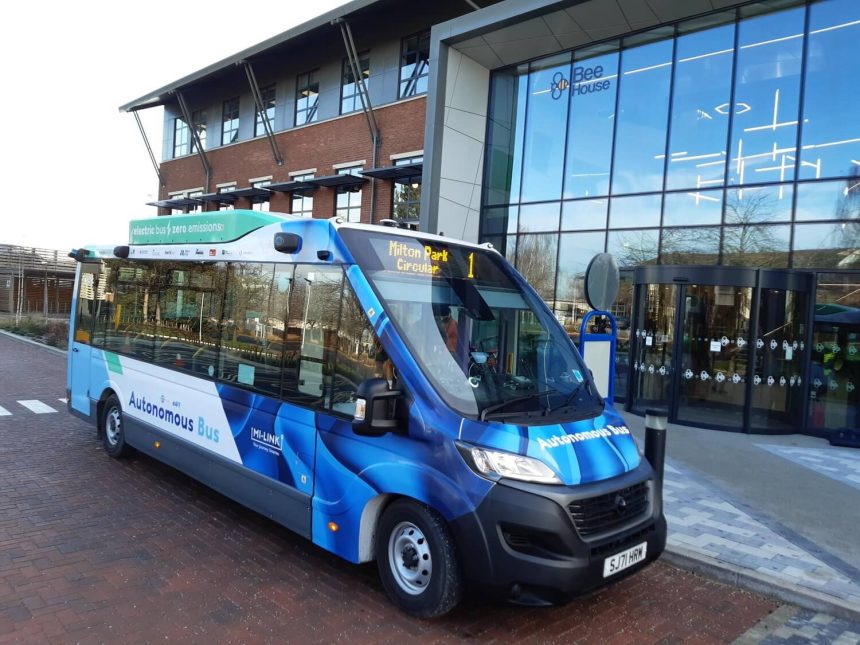We spoke to Jim Hutchinson, CEO of Fusion Processing, and a cross-section of the industry to investigate what driverless technology will mean for the coach and bus industry
The idea of autonomous vehicles is gradually shifting from sci-fi to reality. Driverless features are common in new cars and several trials involving buses have already taken place and, although no one disputes the technology is coming to coach and bus, opinions differ on how soon and how significantly it will transform the industry.
Jim Hutchinson, CEO of Fusion Processing, one of the leaders in creating the technology behind self-driving buses, is predictably bullish on the matter.
He suggests we could see buses without on-board staff as soon as 2027 and thinks autonomy will be “transformational” for the industry. He also hints that Alexander Dennis, a Fusion partner, is developing a new range of buses with that capability as an option.
Others in the autonomous vehicles, and coach and bus industries are much more cautious. Meanwhile, a recently published report from the Transport Research Laboratory (TRL) suggested that completely staff-free coaches and buses would not be seen any time soon.
Driverless coach and bus technology will be ‘transformational’
The Automated Vehicles Act (AVA), passed in 2024, creates the legal framework for vehicles, including buses, to operate on public roads. However, given the secondary legislation still required, full implementation is not expected until late 2027.
So far, trials of autonomous buses and shuttles have taken place with “safety drivers” on board, which has been a requirement save for the alternative of some “complex” mechanisms.
Thus, when it comes to coaches and buses operating without any staff on board, Jim says: “We don’t expect it’ll be widespread until the legislation is passed. So, I would say sort of later in 2027 timeframe, that’s when you’ll really start to see these services come in…

“The technology works and I think certainly, in another two years, people will be more comfortable with that concept. And it’s not like there’s no monitoring going on — the vehicles will be monitored from a control centre and with the appropriate safety provision in place. So, yes, it will happen in that timeframe.”
Jim sees it being deployed first on newer services which wouldn’t be commercially viable to operate with a driver and on the “slightly less challenging” routes. He adds that many routes will continue to need drivers.
It will change the dynamics in the industry. I think it has the potential to have a really positive impact on UK manufacturing as well – Jim Hutchinson
On the significance for the industry overall, he adds: “I absolutely think ‘transformational’ is a good word because I think it will change the dynamics in the industry. I think it has the potential to have a really positive impact on UK manufacturing as well, both in terms of sort of the home and export markets…
“For operators, I think it will make it possible for them to expand the number of routes that they can provide and they won’t be up against the same sort of commercial problems there.” He adds that it could solve the recruitment problem and lead to the creation of more routes.
Jim concedes driverless technology adds to the upfront cost of a coach or bus but points out this would be “very, very small compared to the amount that can be saved” both in terms of staffing and via the adding of otherwise unsustainable routes. The government will need to have a role in meeting this investment and “priming the market” with grants, he feels.
![[5] Alexander-Dennis-Enviro200AV-for-CAVForth-project-2 (1) Driverless tech promises big shift for coach and bus](https://routeonenews.divcomstaging.co.uk/wp-content/uploads/2025/08/5-Alexander-Dennis-Enviro200AV-for-CAVForth-project-2-1-Driverless-tech-promises-big-shift-for-coach-and-bus.jpg)
“There are responsibilities for all concerned,” he says. “Responsibilities for those actually operating the vehicle in terms of making sure that the monitoring, servicing and maintenance is in place. But that wouldn’t be too onerous — it would be just an increment on what is done at the moment, essentially.
“But then, yes, obviously there’s a big responsibility on the providers of the vehicle and the technology. We all understand that and we’re set up for it.”
Cambridge Connector launched
Jim was talking just after the launch of the first on-road passenger trials for the Cambridge Connector, an automated service in the west of the city led by the Greater Cambridge Partnership (GCP) in which Fusion is partnering with Alexander Dennis and the operator Whippet, among others.
A 15-seater Mellor Orion E minibus is in use there and follows on from several trials of smaller vehicles such as the Ohmio autonomous shuttle in Milton Keynes earlier this year. However, the first full-size bus to operate on public service in the UK was CAVForth in 2023.
Using Fusion technology and an Alexander Dennis Enviro200AV single-decker bus, Stagecoach East ran the 14-mile scheduled service from Edinburgh to Ferrytoll. The trial ended as planned in February with the operator citing insufficient ridership to justify continuation.

In December, Stagecoach pulled its support for the Connector project, with GCP saying the operator is “refocusing fully on delivering core bus services across the UK and scaling back its involvement in autonomous deployments”.
CAVForth is now operated on an invitation-only basis for demonstration purposes and Jim says the results of the trial proved invaluable. Despite the Stagecoach move, Jim remains optimistic that operators are supportive.
“I think Stagecoach has taken this to a point where it has achieved what it wants to achieve in that timeframe. I think now it will sit back and take stock…” he says.
“There are several operators that are at various points in the journey and wanting to take it forward. So, from our point of view, there are always operators that want to be a part of it and want to take it to the next level.”
The emergence of driverless ‘pods’
The trials using autonomous “shuttles” or “pods” — carrying up to eight passengers in the case of, for example, the Ohmio vehicles in Milton Keynes — raise the question of whether these would be a threat or an ally of bus in future.
A “brand-new form of transport” is how they are described by Neil Kennett, Editor of Cars Of The Future magazine, specialising in self-driving vehicles. “Certainly for the foreseeable, for 10 years or more, we’re not talking about them replacing buses,” Neil tells routeone.
Roger French, a former Managing Director of Brighton and Hove Buses who remains a vocal observer of the industry, comments: “I think they have obvious applications like a university campus maybe taking people from part of a university to where the main buses are.
“But they would be very, very restrictive. I just can’t see it happening on a more general basis. Older people aren’t going to get on an autonomous vehicle with no member of staff on board.”

Sean O’Shea, CEO of Metroline, believes these pods could complement the bus network. “Philosophically I’m pro-public transport and active travel,” says Sean, who adds that, while buses are perfect for high-capacity, fixed routes, they don’t meet the needs of everyone.
“That’s why there are so many cars. So, having a solution that ensures that the bus does its job to the best of its ability but that allows other users to have options that suit them best and aren’t creating the sort of detriment that cars do is not a bad thing.”
That sentiment was echoed in the city in which the Ohmio pods trial is taking place. Shanika Mahendran, Cabinet Member for Planning and Placemaking at Milton Keynes City Council, sees such shuttles as presenting a first-mile and last-mile option, in common with the likes of e-scooters. As such, it would seem clear they could be a friend to bus in the battle against the private car.
“It is increasingly quite a difficult model to sustain, particularly in somewhere like Milton Keynes, which is quite sparse, which can make bus travel quite difficult,” Shanika says. “Hopefully something like this will help solve some of those issues.”
Ed Cameron, Director at Whippet, proposes that demand-responsive transport might be a good use for this form of vehicle in future, given the high driver costs associated with this form of travel.
Meanwhile, Jim points out applications for such pods are limited and that the future is bus when it comes to autonomy. He says: “I think it’s quite niche and so I think a lot of the potential is with the sort of the mid-sized vehicles and the larger-sized vehicles… I don’t think it’s going to be a widespread shift from the larger vehicles over to lots of smaller vehicles.”
The role of humans in a driverless coach and bus future
Jim’s estimation on the timeframe of totally staffless buses is at odds with that of many in the industry. The TRL report picked out 21 roles which are judged to be either “challenging” or “impossible” to fulfil without a driver.
Ed says that when advertising internally for the role of “safety driver” for the Connector bus, the response was positive. He says: “I don’t think at any point there’s been a sense of ‘this is a threat to my job’.
It might just reduce the amount of time they have to spend driving a little bit and focus more on the customer – Ed Cameron
“I think people are saying in decades and decades probably but that’s not much of a concern in 2025. Even in the next 10 years you will need someone on the bus to perform a number of roles. They will still be a driver. It might just reduce the amount of time they have to spend driving a little bit and focus more on the customer.”
The road to the world of the driverless coach and bus remains an evolving journey rather than an imminent destination. The technology may be almost there, but adoption will depend on public confidence, legal clarity, and commercial viability. It will bring huge changes but exactly what they will be is less clear and the timeframe is even less established.


























